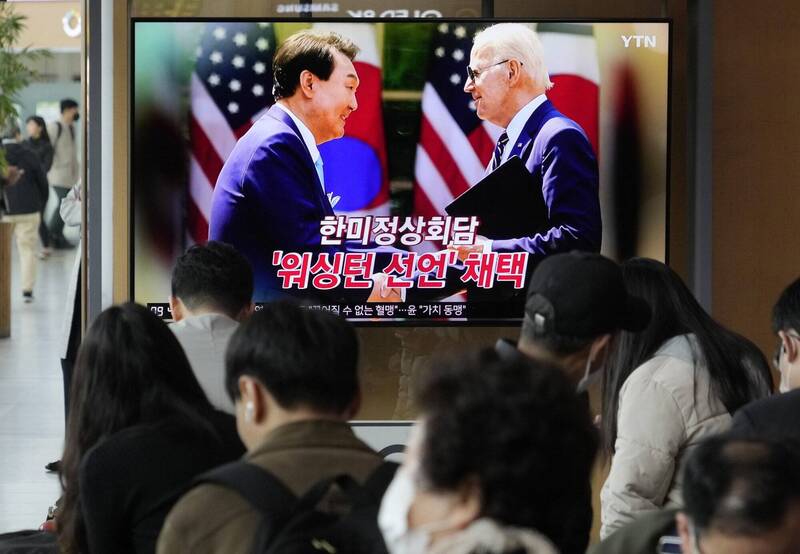A picture of U.S. President Joe Biden, right, and South Korean President Yoon Suk-yeol in Washington is displayed on a TV screen at a train station in Seoul, South Korea.
(Associated Press)
(Central News Agency) Authorities in Washington and Seoul this week announced the "Washington Declaration" (Washington Declaration), which declared that if North Korea used nuclear weapons against the United States or its ally South Korea, it would be the "end" of North Korean leader Kim Jong Un's regime.
In the face of more and more missile tests by the nuclear-armed North Korea, South Korean President Yoon Suk-yue discussed with US President Joe Biden during his state visit to the United States to strengthen security protection for Seoul, and raised the above-mentioned severe threats.
Agence France-Presse sorted out the substantive meaning of this ruthless statement as follows:
Please read on...
●Nuclear umbrella
Biden and Yin Xiyue issued the "Washington Declaration" (Washington Declaration) after their talks at the White House, strengthening the US nuclear umbrella for South Korea.
The content includes other measures such as the routine deployment of nuclear submarines by the United States to South Korea and the strengthening of intelligence sharing in the event of an attack by North Korea.
CNN pointed out that the visit of a US nuclear submarine to South Korea will be the first since 1981.
But because the United States has no plans to deploy nuclear weapons in South Korea, some analysts question the practical value of the declaration.
"Whether North Korea is afraid of deploying a strategic nuclear submarine with a SLBM with a range of more than 7,400 kilometers is open to question," Cheong Seong-chang, director of the North Korea Studies Center at South Korea's Sejong Institute, told AFP.
The submarine's missiles are "too long-range", meaning it may not be able to strike North Korea from South Korean waters.
Each Ohio-class submarine is equipped with up to 20 Trident II ballistic missiles, CNN reported.
The missile has a range of 7,400 kilometers, meaning it can hit any North Korean target from the vast Pacific, Indian or Arctic seas.
"From a military perspective, these submarines don't have to come close to the Korean peninsula in order to reach potential local targets," said Blake Herzinger, a research fellow at the University of Sydney's United States Studies Centre.
A Trident missile can carry multiple warheads to attack different targets respectively.
According to James of California.
The Nuclear Threat Initiative of the James Martin Center for Nonproliferation Studies estimates that each Trident missile can carry four nuclear warheads, which means that a U.S. ballistic missile submarine could Equipped with about 80 nuclear warheads.
In other words, one such submarine could destroy North Korea.
●Thunder Submarine
The U.S. Navy has a total of 14 Ohio-class nuclear-powered ballistic missile submarines (SSBNs), eight of which are homeported in Washington state and six in Georgia.
The 560-foot-long submarines, often called "boomers," displace more than 18,000 tons underwater and are each powered by a nuclear reactor.
The U.S. Navy stated that the Ohio-class submarines stay in the sea for an average of 77 days, and then dock for 35 days for replenishment and repairs. The "Gold" and "Blue" squads are assigned to perform tasks in turn, with 155 crew members in each squad while cruising. Get proper rest and training.
●Extended deterrence
Leif-Eric Easley, a professor at Seoul's Ewha Womans University, told AFP that the state visit "represents a new peak in US-South Korea relations, extending the breadth of security, economic and cultural cooperation." and a full display of depth.”
U.S. officials described the new agreement as similar to Washington's past focus on Europe's strategic defense against the Soviet Union.
Yoon is trying to reassure increasingly nervous South Koreans about U.S. assurances of so-called "extended deterrence," or U.S. assets, including nuclear weapons, to protect allies from attack.
Polls show that a majority of South Koreans now believe South Korea should develop its own nuclear weapons.
Yoon Suk-yue has also previously hinted that Seoul may pursue such an option.
● Will Seoul acquire nuclear weapons?
Absolutely not.
That could create problems, experts say.
Soo Kim, a former CIA analyst, said: "One thing is clear: It means Seoul agrees not to seek nuclear weapons, its nuclear ambitions are curbed."
Gi-Wook Shin, a professor of sociology at Stanford University and an expert on South Korea, told AFP that the Washington declaration was "a step forward".
"I don't think this will be enough to appease the South Korean public who are increasingly demanding that Seoul develop its own nuclear weapons."
●How will North Korea respond?
Experts believe that closer cooperation between Pyongyang's self-declared arch-enemy Washington and Seoul is bound to worry the regime of North Korean leader Kim Jong-un and could prove it with more missile tests.
Chun In-Bum, a retired South Korean army general, told AFP that in public, North Korea would downplay the US message of nuclear deterrence; Without nuclear weapons, the Kim regime will come to an end."
Despite the ban, impoverished North Korea is betting heavily on gross domestic product (GDP) and sticking to a decades-long nuclear program.
Experts believe that Kim Jong-un will not change course.
"It is unlikely that North Korea will give in to these threats and give up its nuclear weapons," Yang Moo-Jin, a professor at the University of North Korean Studies in Seoul, told AFP.
